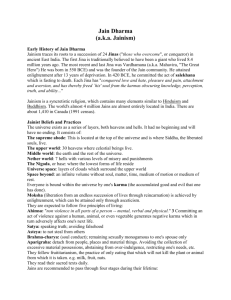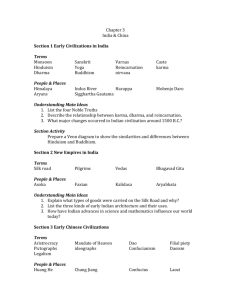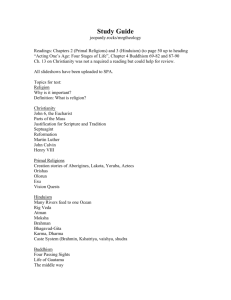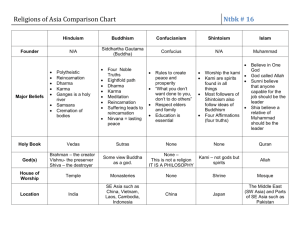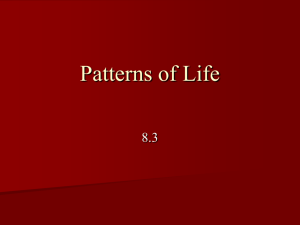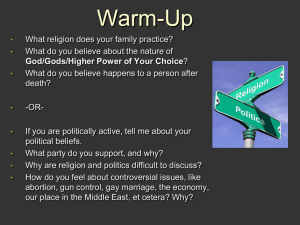Religions of South Asia
advertisement
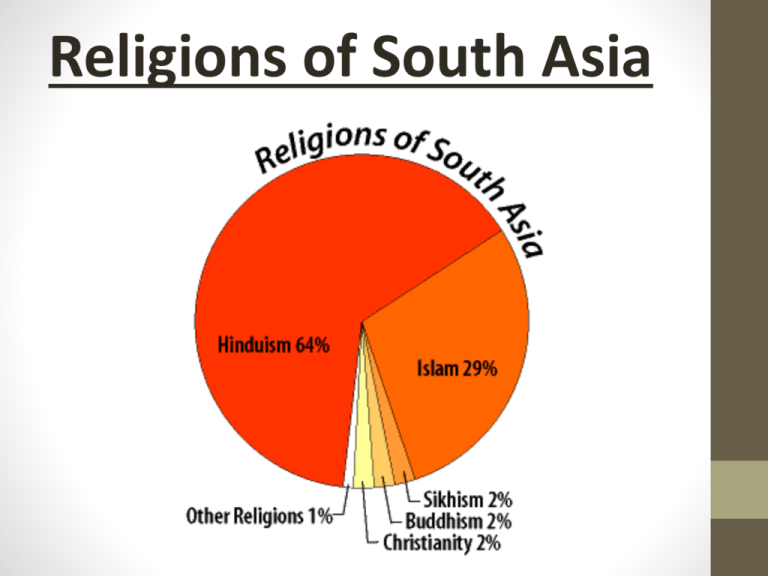
Religions of South Asia • eifvbkvjbnvlkdfjbndlkjfn CULTURE HEARTH OF SOUTH ASIA The Indus River • Where an early culture emerged and developed • Arts and trade routes emerged from isolated tribes and villages to towns and beyond. • Hinduism emerged from the beliefs and practices brought to India by the IndoEuropeans (Aryans). (6th century BC) • Buddhism emerged during the 6th century BC; made the state religion of India in 3rd century BC • Islam sweeps through central India from the 8th -10th centuries AD Karma vs. Dharma The terms dharma and karma often get confused by introductory Hinduism students and with good reason -- they are both products of the cycle of birth and death (reincarnation), but they have entirely different spheres of purpose. Karma is the accumulation of debt of action in the course of a person's samsaric cycle. Every action has a reaction and over the course of a lifetime, if one is doing the right things, they will gradually work off his or her bad karma. If he is acting selfishly and for ego, then he will accumulate more bad karma to work off. With each birth and re-birth, each person finds their "dharma" or duty in order to work off this karma. Some are born to wealthy families, others to poor ones, some to spiritual families, others to evil-doing ones. The question isn't what you are born to, but how you use your life to dissolve as much karma as possible in order to earn release from the cycle of re-birth Hinduism Who – Ancient priests of India When – 5000 –3000 BCE Where – India Holy Books – Vedas, Bhagavad-Gita Major Divisions – Numerous traditions Holy Symbol – Aum (or Om) • • • the three worlds - earth, atmosphere, and heaven the three major Hindu gods - Brahma, Vishnu, and Siva the three sacred Vedic scriptures - Rg, Yajur, and Sama Thus Om mystically embodies the essence of the entire universe. This meaning is further deepened by the Indian philosophical belief that God first created sound and the universe arose from it. As the most sacred sound, Om is the root of the universe and everything that exists and it continues to hold everything together. Basic Beliefs Polytheistic (some say more accurately Henotheistic) – Thousands of deities, many interconnected. Reincarnation through infinite lives and forms Dharma – proper place or role in the universe and society (caste) Karma – cause and effect occurring across lives. Ultimate goal – oneness with “Brahman” (God, Reality) Simple, really… follow your DHARMA to improve your KARMA so that you reincarnate in a better position to reach BRAHMAN. Popular Hindu Deities 1. Ganesha: Easily recognizable as the elephant-deity riding a mouse. He is the Lord of success and destroyer of evils and obstacles. He is also worshipped as the god of education, knowledge, wisdom and wealth. 2. Krishna: Lord Krishna (lived between 3200 and 3100 BC) was indeed the great guru of how to live life on earth. Like all great men, his life was dedicated to helping man fathom the sacred realm of supreme knowledge. 3. Shiva: The Destroyer. He represents opposites of life and death and creation and destruction. 4. Brahma: The God of Creation (creator of the universe and of all beings) 5. Vishnu: The Preserver or sustainer (restores peace and order on earth) Buddhism Holy Symbol Who – Siddhartha Gautama (Buddha) The Dharmachakra, or "wheel of When – 500 BC law," is one of the most important Where – Northern India Buddhist symbols, as it represents the teachings of the Buddha. Holy Books - Tripitaka Major Divisions – Mahayana, Theravada Basic Beliefs No universal creator, only powerful beings. Reincarnation, dharma, and karma still apply. Four Noble Truths: Life is suffering, suffering caused by craving, craving caused by ignorance, ignorance relieved by knowing the Truth. The “Eightfold Path” allows one to attain Nirvana, freedom from existence and suffering The Buddhist’ Noble Eightfold Path The following are believed by Buddhists to guide a person toward greater understanding of the universe. The eight ideals are: • Right views • Right intention • Right speech • Right action The 14th Dalai Lama is the 14th and current Dalai Lama, as well as the longest lived incumbent. Dalai Lamas are the head monks of the Gelugpa lineage of Tibetan Buddhism. Born: July 6, 1935 (age 77), Taktser • Right livelihood Full name: Lhamo Dondrub • Right effort Awards: Nobel Peace Prize, Congressional Gold Medal, More • Right-mindedness • Right contemplation Islam Who – Muhammad When – circa 620AD Where – Arabian Peninsula Holy Books – Quran and the Hadith Major Divisions – Sunni, Shia Basic Beliefs There is no god but Allah, and Muhammad is the messenger of God Quran is word of God. Muslims must perform the “Five Pillars of Faith”. The star and crescent is the best-known holy symbol used to represent Islam. It features prominently on the flags of many countries in the Islamic world, notably Turkey and Pakistan. Sikhism Who – Guru Nanak When – 1400’s Where – Northwestern India Holy Books – Adi Granth Sikhism, founded in South Asia, is the world’s fifth-largest religion with about 25 million followers, including about 500,000 in the United States. Basic Beliefs – • Monotheistic, believe in reincarnation. • All people are equal in God’s eyes. • Humans must free themselves from negative thoughts and actions to attain salvation, become one with God. • Teachings are passed down through teachers, or “Guru”. • Sikh’s are bound by the “Five K’s”… kēs (uncut hair), kaṅghā (small wooden comb), kaṛā (circular steel or iron bracelet), kirpān (sword/dagger), and kacchā (special undergarment). Sikh Holy Symbol • The Khanda is the symbol of the Sikhs, as the Cross is to Christians or the Star of David is to Jews. It reflects some of the fundamental concepts of Sikhism. The symbol derives its name from the doubleedged sword (also called a Khanda) which appears at the center of the logo. This double-edged sword is a metaphor of Divine Knowledge, its sharp edges cleaving Truth from Falsehood. • The circle around the Khanda is the Chakar. The Chakar being a circle without a beginning or and end symbolizes the perfection of God who is eternal. • The Chakar is surrounded by two curved swords called Kirpans. These two swords symbolize the twin concepts of Meeri and Peeri Temporal and Spiritual authority introduced by Guru Hargobind. They emphasize the equal emphasis that a Sikh must place on spiritual aspirations as well as obligations to society. Sikhism continued…….. • Sikhism: a monotheistic religion, founded in the Punjab c1500 by the guru Nanak, that refuses to recognize the Hindu caste system or the Brahmanical priesthood and forbids magic, idolatry, and pilgrimages. Jainism Who – Indus Valley priests When – 900’s BC Where – India Holy Books – None Major Divisions – “Whiteclad”, “Naked” Basic Beliefs – • No divine being, universe is cyclical • Reincarnation is eternal • Goal is to perfect your soul and become an enlightened being • Jains believe in total non-violence against all living things • Monks take many vows and give up nearly everything…. Even clothes, in some cases. Jain Holy Symbol • • • • • • The Jain Symbol is a congregation of various symbols, each having a deeper meaning. This symbol was adopted by all sects of Jainism while commemorating the 2500th anniversary of the nirvana of Lord Mahavira. The outline of the symbol is defined as the universe (Lok). The lower part of the symbol represents the seven hells (Naraki). The middle part of the universe contains the Earth and the planets (Manushyalok). The upper part contains the heavenly abodes (Devlok) of all the celestial beings and abode of the Siddhas (Siddhashila). Jains believe that this universe was neither created by anyone, nor can it be destroyed by anyone. It may change its form, but otherwise, it has always been and will always be here. The raised hand means stop. The word in the center of the wheel is "Ahimsa". Ahimsa means non-violence. Between these two, they remind us to stop for a minute and think twice before doing anything. This gives us a chance to scrutinize our activities to be sure that they will not hurt anyone by our words, thoughts, or actions. We are also not supposed to ask or encourage others to take part in any harmful activity. The wheel in the hand shows that if we are not careful and ignore these warnings and carry on violent activities, then just as the wheel goes round and round, we will go round and round through the cycles of birth and death. The four arms of the swastika remind us that during the cycles of birth and death we may be born into any one of the four destinies: heavenly beings, human beings, animal beings, (including birds, bugs, and plants) and hellish beings. Our aim should be the liberation and not the rebirth. T The three dots above the swastika represent the three jewels of Jainism: Samyak Darshan (Right Faith), Samyak Jnan (Right Knowledge), and Samyak Charitra (Right Conduct). The right knowledge means having the knowledge that soul and body are separate and that the soul, not the body attains the salvation. The right conduct means that our actions should be void of attachment and hatred. At the very top part of the Jain Universe symbol is a small curved arc. This arc represents the abode of the Siddhas. It is known as the Siddhashila. It is the final resting place of the liberated souls. The dot represents a siddha. In order to achieve this stage, a soul must destroy all attached karmas. Every living being should strive for this state of the Salvation or Liberation. Jainism continued……. • Jainism: a dualistic religion founded in the 6th century b.c. as a revolt against current Hinduism and emphasizing the perfectibility of human nature and liberation of the soul, esp. through asceticism (practicing extreme self-denial of physical and other worldly pleasures for religious reasons) and nonviolence toward all living creatures. • In Jainism, nirvana means final release from the karmic bondage. Mehndism Who – Daler Menhdi When – 1998 Where – India Holy Books – Lyrics to Tunak Tun Major Divisions – Pullers of the String, Riders of the Pony Basic Beliefs – • Four incarnations of Daler Mehndi (air, fire, water, earth) came to Earth to save mankind from religions that don’t have dancing or cool turbans. • When you die, you turn into a big ball of shiny stuff and you fly around in a Daler Mehndi video forever. If you’ve been good, you get to live in the Tunak Tun temple, which is actually the Kremlin in Moscow for some reason. • Turbans are awesome, and beards are awesome. • If you want to be happy, learn the words and moves for “Tunak Tun”. You will never be as happy as Daler Mendhi, but it can’t hurt to try.
